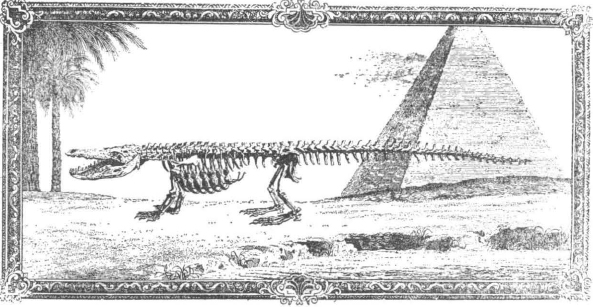Glossary of Drugs Prescribed or Dispensed in Colonial New England*
This glossary has been compiled from the drugs listed in the ledgers of Drs. Josiah Bartlett, Benjamin Rowe, Jr., William Aspinwall, and David Townsend, as described in the text. For constituent ingredients appearing in capital letters, see their definitions elsewhere in the Glossary. The drug properties, or classes, given for each are those included in James Thacher’s descriptions of each drug, as defined below. An asterisk (*) following a drug class indicates that the drug defined still finds use in a similar way today. Other modern uses, if any, are given in parentheses at the ends of definitions. For agents that begin with words such as balsam, elixir, liniment, sal, spirits of, and unguent, only the key word is indexed here.
abietis, balsam: Same as balsam drops.
absinthum, sal: Same as tartar, salt of.
absorbents: Agents which absorb noxious materials from the body; e.g., one Absorbent Laxative prescription includes magnesia alba, rhei, anise, loaf sugar, and cinnamon water.
acid drops: Probably vitriol, elixir.
aerugo: Same as verdegria.
alba, unguent: Olive oil, White wax, litharge. A plaster for burns.
alexipharmical tincture: Literally, an antidote to a poison. Same as huxham’s tincture. Chief ingredient is cortex peruviana. Astringent.
alkaline salt: Sodium carbonate. Lithontriptic.
aloes: Extract of Aloe barbadensis. Available in two grades, Socotorina, the purest, named for an island in the Arabian Sea, and Hepatica. Cathartic*
alumen: Alum, Potassium Aluminum sulfate. Astringent. (Now used as a deodorant.)
amara, tinctura: Same as stomachic elixir.
ammonia, spirits of: Thacher specifies that it is used only as a menstruum for vegetable drugs. (Today, consists of ammonia, ammonia carbonate, and essential oils in alcohol, used as reflex stimulant to respiration.)
ammoniac, gum: Dorema ammoniacum extract. Antispasmodic; Expectorant; Cathartic; Diaphoretic; Diuretic.
ammoniac, sal: Ammonium chloride. Diaphoretic; Emetic; Diuretic*
ammoniaci, lac: Ammoniated milk. Expectorant.
anise, semina or ol: Seeds, or oil from seeds, of Pimpinella anisum. Tonic.
anodyne balsam: Ingredients: Soap shavings, camphor, volatile oil of rosemary, opium, and alcohol. Narcotic.
antifebritic powders, pills, etc.: Same as febrifuges.
antihysteric plaster: Ingredients: litharge, assa fetida, galbanum, Yellow wax. Applied to umbilical region. Antispasmodic; Expectorant; Emmenagogue; Anthelminthic.
anti-icterics: Medicines used in the treatment of jaundice (icterus), such as, sometimes, elixir proprietatis.
antimony: Native ore, consisting of sulfide or oxide. Emetic, Cathartic; Diaphoretic.
antimony, crocus of: Antimony oxide; generally used only in preparing other antimony salts.
antiphlogistics: Medicines used in fevers, often Diaphoretics.
apozema, -ta: Infusions or decoctions of vegetable drugs.
aqua calcis: Lime (Calcium hydroxide) water, usually made by dissolving quicklime, Calcium oxide, in water. Astringent; Antacid.
aqua ophthalmia, or Collyria: Ingredients: Lead Acetate, Zinc Sulfate and laudanum. Zinc sometimes omitted. Narcotic.
arabic, gum: Extract of Acacia Senegal. Demulcent.*
areci: Extract of Areca catechu. Astringent; Emmenagogue.
argentum vivum: Mercury (“quick silver”).
aromatic tincture: Ingredients: cinnamon bark, Cardamom seeds, Pepper, dilute alcohol. Tonic.
assa fetida, gum: Extract of Ferula asafetida. Antispasmodic; Expectorant; Emmenagogue; Anthelminthic
asthmaticus, elixir: Same as paregoric.
aurantium, cortex: Juice and rind of orange. Refrigerant; Antiscorbutic*
balsam drops: Volatile oil of Canada balsam, Abies balsamea. Epispastic.
baricis: Barium sulfate. Tonic; Diaphoretic, Diuretic; Escharotic.
bark: See peruviana, cortex.
basilicon ointment: One with “sovereign” virtues. Thacher specifies a combination of Hog’s lard, Pine resins, Yellow wax, and sometimes Olive oil. Emollient.
bateman’s pectoral drops: Patented in 1726, as Diaphoretic, Diuretic, Lithontriptic. Actual ingredients unknown; reconstructed in 1833 in Philadelphia as Dilute alcohol, Red sanders, Opium, Areca catechu, Camphor, and Anise oil.
benzoin, flowers of: Benzoic acid, extracted from Styrax benzoin. Diaphoretic. (Still used in Whitfield’s Ointment, with Salicylic Acid, as fungicide.)
bitter infusion: Thacher describes one consisting of gentian, Orange peel, Coriander seeds, and dilute alcohol. Tonic.
bitters: Extract of Cusparia angustura. Tonic. (Sometimes, a bitter drug, e.g., peruvian bark, or hiera picra.)
black hellebore: Helleborus niger, now also known as Christmas rose. Cathartic.
bole [armeniac, Armoniak, etc.]: Earth imported from Armenia. Astringent. However, bole may sometimes have been used in its generic sense as a large pill containing opium, sal ammoniac, gum Arabic, or any other active ingredients.
borax: Sodium borate. Diuretic; Emmenagogue; Emollient. (Still used in dusting powder and, as acid, in an ophthalmic ointment.)
bryonia: An extract of Bryonia creticum, subsp. dioica, a gourd.
buckthorn, syrup of: Juice from berry of Rhamnus catharticus. Cathartic. (Different from bark, which is a Tonic and Astringent. The bark of R. frangula is also Cathartic.)
calamine: Same as cerate, liniment.
calib., calyb.: See chalybeate.
calomel: Mercurous chloride. Cathartic; Diuretic; Anthelminthic; Antivenereal.
camphor, gum or elixir: Extract of Cinnamonum camphora. Narcotic [although Opium is an antidote]; Antispasmodic; externally, antirheumatic. (Now used as antipruritic, and in paregoric.) Camphor taken by mouth may produce severe toxicity; see: Robert Kopelman, Sanford Miller, Raymond Kelly, and Irving Sunshine, “Camphor Intoxication Treated by Resin Hemoperfusion,” Journal of the American Medical Association 241 (1979), 727–728.
canella: Aromatic inner bark of Canella alba or C. winteranda. Used in hiera picra.
cantharides: Powdered Spanish flies, Lytta (formerly, Cantharis) vesicatoria. Epispastic; Diuretic. When applied externally, its blistering activity stimulates the activity of debilitated internal organs. (Now used to remove finger warts.) The active ingredient of extracts of the Spanish fly, which is actually a beetle, cantharidin, is not completely innocuous to man. Its toxicity was most recently explored in: Simon W. Rabkin, Janet M. Friesen, John A. J. Ferris, and Henry Y. M. Fung, “A Model of Cardiac Arrhythmias and Sudden Death: Cantharidin-induced Toxic Cardiomyopathy,” Journal of Pharmacology and Experimental Therapeutics, 210 (1979), 43–50.
capivi, balsam of: Extract of Copaifera officinalis. Tonic; Diuretic; Cathartic.
carbonas ammoniale, or aqua carbonas ammoniae: Mixture of Ammonium Carbonate and Ammonium Carbamate. Used in making ammonia, spirits of. Tonic.
carbonas calcis, sal: See sal carbonas calcis (sal c: c:).
cardiac drops: Ingredients: cinnamon in Syrup of orange peel. Sometimes, theriac. Tonic.
carminatives: Agents that facilitate expulsion of gas from intestine.
cascarilla: Powder of Croton eleutheria root. Astringent [?], Tonic [?].
castor oil: Extract from seeds of Ricinus communis. Cathartic;* Anthelminthic.
cathartic dulcis: Same as calomel.
caustics: The most common was Silver Nitrate, which is still in use. Another was Potassium carbonate, “pearl ash.” Escharotic; Cathartic; Anthelminthic; Lithontriptic when instilled directly into bladder.
cerate: Beeswax.*
cerate, liniment: Zinc silicate in wax or oils; calamine. Emollient.*
cerralina: Gall nuts, nest of Cynips quercifolii in Oriental Oak, Quercus cerris. Astringent.
cerusse: litharge, for plasters and Emollients.
chalybeate: Iron tartrates (actually, probably oxides) in wine. Astringent. Used in treatment of chlorosis.*
chamomile, flowers of: Dried powdered flowers of Anthemis nobilis. Tonic; Diaphoretic; Antispasmodic; Emollient.
chart: ?Charcoal, used as an absorbent, i.e., Cathartic; also to decrease rancidity of oils, to purify ship’s water, and to diminish foul odor of carious teeth. (Now used to absorb alkaloids in stomach, after potential poisoning.) cinchona: See peruviana, cortex.
cinnabar nativa: Mercuric sulfide, mercury ore. Sialogogue.
cinnamon: Bark of Cinnamonum zeylanicum or C. lourerii. Tonic.
cochineal: Brillant red dye made from females of a tropical American scale insect, Dactylopius coccus. Used to color several drugs.
collyria: Same as aqua ophthalmia.
columba (or colombo): Root of Swertia caroliniensis. Tonic.
contrayerva: Root of Dorstenia contrajerva. Astringent; Tonic; Diaphoretic.
copaiba, copaiva: See capivi.
cordial julep: Usually a clear, sweet, nonfatty liquid, without sediment, probably containing
camphor. Narcotic. corral: Same as sal carbonas calcis.
cortex: Bark. When used alone, almost always refers to peruviana, cortex.
cortex peruviana: See peruviana, cortex.
cosmetic unguent: Often made from root of Lords-and-ladies, Arum maculatum. Also, a Tonic.
cremor tartar: Sodium potassium tartrate (Rochelle Salt). Cathartic;* Diuretic.
crocus martialis: Iron rust; seldom used except in combinations, e.g., to prepare martial flowers,
curcuma: Root of turmeric, Curcuma longa. Tonic.
de mel: See mel and mellilot.
dessicativum rubrum, unguent: A plaster made with litharge, calamine, and camphor,
diachylon, emplastrum: Common plaster made of litharge. Used to protect excoriations of skin.
diacodium: A liquid opium preparation about two percent as potent as Liquid laudanum,
dialthea, unguent: Extract of marsh mallow, Althea officinalis. Emollient, for internal disorders.
diapalma, emplastrum: Dessicating plaster made of Palm Oil, litharge, Olive Oil, and Water.
diet drink: See liquorice.
diuretic salt: Potassium acetate. Diuretic; Cathartic.
dorsal: To be applied to the patient’s back.
dover’s powder: Ingredients: ipecac, opium, potassium sulfate. Introduced by Thomas Dover in 1740. Diaphoretic.
dulcified spirit[s] of nitre, or spirit[s] of nitrous ether: Nitrous acid in alcohol. Refrigerant; Tonic, Diaphoretic, Diuretic; Antispasmodic.
egyptiae, unguent: Ingredients: Vinegar, Honey, verdegris. Escharotic.
elapi: Monobasic and Dibasic Calcium phosphates. Same as hartshorn. Used in Rickets.
eleutheria, cortex: See cascarilla.
embrocation: An ointment to be rubbed in.
emetic: This may well be Thacher’s emetic weed, Lobelia inflata, or Indian tobacco. (However, any other emetic substance may also be meant.) Emetic; Tonic.
epispastic ointments: Contain cantharides.
epsom salt: Magnesium sulfate; see sal catharticus amarus. essence veneris: Mercuric chloride (“corrosive sublimate”), used in Syphilis.
ethiops mineralis: Mercuric sulfide. Anthelminthic.
febrifuges: Some common formulations for fever included: Sal nitre, tartarized antimony, opium, and calomel; Glauber’s salts, lemon juice, sugar, and water; Sal nitre, lemon juice, and water.
fenugreek: From Trigonellafoenum-graecum. Used chiefly as an aromatic.
fetid tincture, powder, or pill. Chief ingredient is assa fetida.
flavus, balsam: Same as turpeth mineralis.
foliae sennae: Leaves of senna.
galbanum, gum: A Plaster of which rosemary is the chief ingredient.
galingale: Extract of Sedge, Cyperus longus (also, sometimes, of Alpinia or Kaempferia species). Tonic.
gargar[isma]: A gargle.
gentian: Root of Gentiana species, often G. lutea. Tonic.
glauber’s salt: Sodium sulfate. One of several salts introduced by Johann Rudolph Glauber about 1650. Cathartic*
guaiac, gum: Resin of Lignum Vitae, Guaiacum officinale, or G. sanctum. Tonic; Diuretic; Diaphoretic, Cathartic.
hartshorn: Same as elapi.
haustus catharticus: “Cathartic draught.” The 1786 Edinburgh Dispensatory suggests: Scammony, Spirits of Rosemary, and Syrup of Buckthorn; or, a mixture of Jalap, Ipecac, Juniper water, Linseed infusion, and Simple Syrup; or, Glauber’s cathartic salt with Manna and Cardamom tincture.
hedera, ol: Extract of Hedera helix and other ivy species. Use unknown.
helleborus niger: Same as black hellebore.
hemlock, emplastrum: Resin of Pinus balsamea. Tonic; Diuretic; Cathartic.
hiera picra: Tincture of aloes and canella. Cathartic.
hippocondrial infusion: Probably to be applied to hypochondrial area, in manner of antihysteric plaster,
honey: Cathartic; Expectorant.
hord[eum]: Barley water, from Latin name Hordeum distichon, made from grain or fresh bread. Used as nourishment and as Refrigerant.
hungary [queen of] water: rosemary flowers and tops distilled with wine. Antispasmodic.
huxham’s tincture: Ingredients: cortex peruviana, orange peel, serpentina, cochineal, saffron, and dilute alcohol. Introduced by John Huxham about 1750. Same as alexipharmical tincture. Astringent.
hydrargyrus: Mercury.
ichthyocolla: Fish glue, from sturgeons, Acipenseridae. Emollient.
ipecac: Extract of Cephaelis ipecacuanha. Emetic; Diaphoretic. (Active principle, emetine, now used for amebic dysentery.)
jalap: Root of Exogonium purga. Very potent Cathartic.
julep: A liquid medicine with an agreeable taste.
juniper: Extract of Juniperus communis or J. sabina. Tonic; Diaphoretic; Diuretic; J. sabina used as Emmenagogue.
lactuca: Milky juice of Garden lettuce, Lactuca sativa, or Wild lettuce, L. virosa. Narcotic; L. virosa also Diuretic, Diaphoretic, Cathartic.
laudanum, liquid: Alcoholic extract of opium. Narcotic.
lavender, compound spirits of: Solution of Lavandula species, rosemary, cinnamon, clove buds, nutmeg, Logwood (Haematoxylon campechianum). Tonic.
lectisternium, unguent: An all-purpose unguent for the sickroom.
lenitive electuary: A honey paste lozenge containting senna, Coriander seeds, liquorice, figs, prune pulp, tamarind pulp, and double refined sugar. Mild cathartic.
liniment de minio negro: Consists of red lead, cerate, and Honey of squills,
liniment, sapo: Mixture of Soap, camphor, volatile oil of rosemary, and alcohol.
liniment, simple: Olive oil, 4 parts, and white wax, 1 part. Compare with ointment, simple,
liquorice: Extract of root of Glycerrhiza glabra. Demulcent; also used as a diet drink.
litharge: Lead monoxide, PbO, white lead.
locatelli, or lucatelli, balsam of: Very expensive preparation of “Dragon’s Blood,” from Dragon Tree (Dracaena draco) or from Daemonorops draco. Emollient with Astringent properties.
mace: See nutmeg.
magnesia alba: Magnesium carbonate. Antacid;* Cathartic.
manna, gum: Resin of Fraxinus ornus. Cathartic.
martial flowers: Mixture of iron rust and ammonium chloride, resulting in ferric chloride. Preparation and efficacy uncertain, according to Thacher; probably Tonic.
mel: Honey; sometimes, mellilot.
mellilot: Sweet Clover [Melilotus alba and M. officinalis] honey or, sometimes, flowers. Cathartic; Expectorant.
mentha: Extract of Peppermint, Mentha piperita. Tonic.
mercurial pills: Mixture of elemental mercury, Conserve of red roses, and starch or liquorice. Cathartic.
mercuriale, unguent: A plaster made with elemental mercury,
mercuric precipitate rubrum, or cinnabar.
mercuric precipitate rubrum: Mercuric oxide. Escharotic.
mindererus, spirits of: Ammonium acetate, originally extracted from aloes. Introduced by Raymond Minderer in 1610. Cathartic; Diaphoretic.
minium: Same as red lead.
morrain, unguent: Probably an unguent for horses or other animals with a murrain, any of several epidemic diseases of farm animals, e.g., anthrax.
moschata, as in nux moschata mare: nutmeg.
myrrh: Extract of Commiphora abyssinica. Tonic; Diaphoretic; Expectorant.
neapolitan unguent: Ingredients unknown.
nervinum, unguent: Mixture of oil extracted from bovine hoof, wine, and ol terebinth. Tonic; Emollient.
nicotiana, unguent or cathartic: Tobacco, Nicotiana tabacum. Narcotic; Diuretic; Cathartic when given as enema.
nitre, spirit of [glauber’s]: Nitrous acid. Cathartic; also used as a fumigant to destroy contagion. Also see dulcified spirit of nitre and glauber’s salt.
nutmeg (and mace): Seed of Myristica fragrans; Mace is the dried external seed coat. Tonic; Astringent.
nux moschata [mare]: nutmeg.
ointment, simple: Olive oil, five parts, and white wax, two parts. Compare with liniment, simple.
oliva, ol: Olive oil. Cathartic;* Refrigerant. Also used in enemas, gargles, plasters, etc.
ophthalmic unguent: Same as tutiae, unguent, or, perhaps, the balsam invented by Leonardo Fioravanti about 1650.
opium: Dried exudate of seed pods of Papaver somniferum. Used in several preparations, e.g., laudanum, paregoric, elixir asthmaticus. Narcotic* [However, opium was used as much for its constipating activity as for its less well understood analgesic properties in the eighteenth century.]
oxymel: Drink made of vinegar and honey. Cathartic; Expectorant. Also see squills, oxymel of.
Paracelsus, emplastrum: Probably same as diachylon. The original Unguentum Sympatheticum of Paracelsus included, among other ingredients, boar or bear fat, burnt worms, boar brain, mummy powder, bloodstones, and moss from the skull of a man who had been hanged.
paregoric elixir: Mixture of opium, benzoic acid, camphor, volatile oil of anise seed, and alcohol. Also known as Camphorated Tincture of Opium, and elixir asthmaticus. The adjective “Paregoric” means “soothing.” Narcotic;* also used for Cough and for Diarrhea.*
pectoral decoctions, mixtures, etc.: Medicines useful in treating disorders of the chest. Many were empirically compounded; see, e.g., bateman’s pectoral drops. One in common use in New Hampshire in the late eighteenth century contained: Zinc chloride, quassia, Orange peel, and columba root in wine.
peptic powder, pill, etc.: A medicine which stimulates digestion by the stomach; usually contains drugs regarded as Tonics.
peru, balsam of: Extract of Myroxylon pereirae. Tonic. [Not to be confused with Peruvian bark.]
peruviana, cortex: Bark of Cinchona officinalis, Quinine. Recognized as specific therapy for Agues, also known as Intermittent Fevers, and now known as Malaria,* but because of the drug’s Astringent property. By extrapolation from this valuable property, the drug was prescribed for many other diseases as well; true Intermittent Fevers were rare in New England at least, but diseases with fevers of other kinds were common. Peruvian Bark was also the chief ingredient of alexipharmical tincture, huxham’s tincture, etc., for the same reasons.
phosphate mixture: Sodium and Calcium phosphates, for rickets.
pill unique: A proprietary medicine containing Mercury and Antimony. Cathartic.
pinkroot, carolina: Root of Spigelia marilandica. Anthelminthic; Cathartic; Emetic.
polychrestum (polychris), balsam or sal: Potassium sulfate. Cathartic.
prickly ash: Twigs from Zanthoxylum americanum, Toothache tree, or other Z. species (Thacher, probably mistakenly, specified Aralia spinosa). Diaphoretic.
proprietatis [paracelsi], elixir: Tincture of aloes and myrrh. Cathartic; Tonic; Expectorant; Diaphoretic; and as a surgical dressing.
prunella: Probably Self-Heal, or Heal-All, Prunella vulgaris, or possibly Bugle, Ajuga reptants; less likely, Sal Prunella, fused Potassium Nitrate (Saltpeter).
pulegi: Extract of Pennyroyal, Mentha pulegium. Tonic. Sometimes used as an abortifacient today, it can cause severe liver damage: John B. Sullivan, Jr., Barry H. Rumack, Harold Thomas, Jr., Robert G. Peterson, and Peter Bryson, “Pennyroyal Oil Poisoning and Hepatotoxicity,” Journal of the American Medical Association, 242 (1979), 2873–2874.
purgative apozemata: A very strong purgative (Cathartic).
quassia: Bark of Quassia amara, Quassy tree, or Surinam Quassia. Tonic; Antispasmodic.
quicksilver: Mercury.
raisins: Cathartic.
red lead: Lead tetroxide, Pb3O4; minium,
restoratives: Tonic drugs.
restringent: Astringent.
rhei: Officinal, or Chinese, Rhubarb, Rheum palmatum or R. officinale. Cathartic; Astringent.
ricini, ol: See castor oil.
rosemary: Leaves, or oil, of Rosmarinus officinalis.
rubrum, balsam: Same as red lead, or minium, plasters.
rufus’ pills: Compounded of aloes, myrrh, and saffron. Probably named for second-century Roman physician. Cathartic.
sacc [harum officinarum]: Sugar, used for nourishment, as a preservative, or to disguise an unpleasant drug taste; sometimes, as molasses.
sacra, tinctura: Tincture of aloes, Cardamom seeds, Ginger root, and wine. Cathartic; Tonic.
saffron: Dried stigmas of Crocus sativa, used as flavor and for yellow coloring.
sal carbonas calcis (sal C: C:): Calcium carbonate. Antacid.*
sal catharticus Amarus: Magnesium sulfate, Epsom salt. Cathartic*
sal c: c: Abbreviation for sal carbonas calcis. Sometimes, for Sal Cornu Cervi (literally, “hartshorn”), Ammonium Carbonate.
saline: Sodium chloride. Tonic; Cathartic.
sal mirabile glaube: See glauber’s salt.
sal nitre: Potassium nitrate, Saltpeter. Refrigerant; Diuretic.
salop: See sassafras. The original “Salep” was made from dried tubers of Orchis species.
sal tartari: See tartar, salt of.
salutis, elixir: Tincture of senna, jalap, Coriander, Caraway, and Lesser cardamom. Cathartic.
sambucus: Juice of ripe berries of Elderberry, Sambucus niger. Cathartic.
sapo: Soap, made with animal fats and Sodium hydroxide.
sapo, venetian: Venetian soap, made with Olive Oil and Sodium Hydroxide. Some “Saponaceous Pills” also included opium or rhei; the soap was thought to promote their absorption.
sassafras: Infusion of leaves of Sassafras albidum. Cathartic; Tonic; Diuretic; Diaphoretic.
saturn, extract of: Lead acetate in water. Plaster.
saturnine anodyne pills: Lead acetate, ipecac, and opium.
saturnine ointment: ointment, simple, twenty parts, and Lead Acetate, one part. Plaster with Refrigerant properties.
savine: See juniper.
saxifrage: Any plant of genus Saxifraga. Therapeutic properties unknown.
scammony: Root of Convolvulus scammonia, Syrian bind-weed. Cathartic.
senna: Leaves of Cassia acutifolia or C. angustifolia. Cathartic; Diuretic.
serpentina: Root of Virginia Snakeroot, Aristolochia serpentaria (not to be confused with Polygala senega). Tonic; Diaphoretic.
spermaceti: Oil from head of sperm whale, Physeter catodon; other agents, e.g., opium or balsam of peru, might be added. Demulcent; used in many lotions, etc., and for gonorrhea.
squill: Bulb of Sea Onion, Urginea (or Scilla) maritima. Diuretic; Cathartic in high dose; also see squills, oxymel of, used for persistent cough.
squills, oxymel of: Drink made with “Vinegar of squills” and Honey. Diuretic; probably Cathartic; for persistent cough.
stomachic elixir or tincture: gentian root, orange peel, canella bark, cochineal, and dilute alcohol. Tonic.
stomachic pills, powders, etc.: Usually composed of rhei, aloes, myrrh, and mentha. Another formulation consists of gentian and canella. Gentle Cathartic; Tonic.
stoughton’s elixir, tincture, etc.: A proprietary medicine patented in 1712; ingredients other than alcohol unknown. Regarded as a Tonic, especially as a stomachic.
strengthening plaster: Composed of red lead, pine resin, yellow wax, and olive oil. Used to strengthen leg muscles.
succ[inum]: Amber and its distillation products:
ol Succinum [Oil of Amber]: Tonic; Antispasmodic. sal Succinum [Salt of Amber]: Cathartic; Diuretic.
sudorifics: Diaphoretics.
sulfur, balsam of: Sublimated sulfur in olive oil. Cathartic. (Used now for skin disorders.)
sulfur, flowers of: Same as sulfur, balsam of.
supplantiva, elixir: An unguent applied to the soles of the feet, to draw noxious materials down and out of the body.
tartar emetic: Antimony potassium tartrate. Emetic; occasionally Cathartic; Diaphoretic; Expectorant. (Now used for schistosomiasis and granuloma inguinale.)
tartar, salt of: Potassium carbonate. Diuretic.
terebinth, ol: Volatile pine oils; Turpentine. Diuretic; Diaphoretic.
thebaic tincture: Same as liquid laudanum. Narcotic.
theriac: Theriaca andromachi, or Venice Treacle, a relatively weak opium preparation. Narcotic. The Reverend Thomas Harward of Boston proposed a simplified method for preparing this exemplar of polypharmacy in the first book on a drug to be published in America, in 1732; see: Glenn Sonnedecker, “Harward’s Electuarium . . . Earliest Drug Treatise Published by an American Colonist?,” Pharmacy in History, 19 (1977), 24–38. Harward was also an extra-licentiate of the Royal College of Physicians, London.
tormentilla: Tormentil, or Septfoil, Potentilla erecta (or P. tormentilla). Astringent, laudanum was sometimes added.
tragacanth, gum: Extract of Astragalus gummifer, used to increase viscosity of solutions, and as Demulcent.
traumatic balsam: Tincture of benzoin, balsam of peru, aloes, and Alcohol. Expectorant; Tonic.
turmeric: Usually, same as curcuma. May sometimes have referred to Bloodroot, Sanguinaria canadensis, used as Tonic, sometimes as Emetic, Cathartic, or Expectorant.
turpentine, venice: Volatile oil of larch, Larix spp. Diuretic.
turpeth mineralis: Mercuric subsulfate, HgSO4 · 2H2O. Strongest mercurial Emetic; Sialogogue; Errhine.
tutiae, unguent: Impure Zinc oxide with Lead or Copper oxide, in an appropriate base. Emollient. (Zinc oxide is still the chief ingredient of calamine.)
tutty: Same as tutiae, unguent,
umbel plaster: One that surrounds a limb.
unguent, simple: See ointment, simple.
uva ursi: Bearberry, or Wild Cranberry, Arctostapliylos uva-ursi. Tonic.
valerian: Root of Valeriana officinalis. Antispasmodic; Tonic.
van swieten’s antivenereal: Mercuric chloride (“corrosive sublimate”). Promoted by Gerhard van Swieten about 1750. Cathartic.
vegeto-mineral water: Lead acetate in brandy and water. Plaster.
verdegris: Copper acetate. Escharotic, for surgical dressings.
vessicativum, tinctura: A blistering agent, often made with cantharides.
viridem, balsam: See verdegris.
vitriol alba: White vitriol, Zinc sulfate. Emetic. (Zinc sulfate is still used for a rare form of bacterial conjunctivitis, and in skin lotions.)
vitriol antimonium cerate: Antimony sulfate in cerate. Emetic; Cathartic.
vitriol, elixir: Sulfuric acid, cinnamon, and Ginger root in alcohol. Tonic.
vitriol, ol: Sulfuric acid. Astringent; Tonic.
vitriol romanum: vitriol with Copper sulfate. Tonic.
volatile drops: Volatile oil of Cajeput tree, Melaleuca leucadendron. Antispasmodic; Tonic. Other “volatile” medicines included camphor and/or sal ammoniac.
vulnerary: A medicine which facilitates wound healing.
white lead: Lead monoxide, PbO. litharge.
wine, spirits of: Wine, or other alcohol beverage. Tonic.
wormseed: Seed of Jerusalem Oak, Chenopodium ambrosioides, var. anthelminthicum. Anthelminthic.
Bleeding Implements and Drug Chests of Colonial New England
Colonial New England physicians probably used ordinary household porringers or other ceramic bowls more often than specially made basins to collect the blood they let escape from their patients’ circulations. The Directions for W. Crawley’s Family Medicine Chest (London, n.d., but about 1790) (Boston Medical Library, rs 125 c85, pp. 12–13,) gave no specific directions for the amount of blood to be removed:
It is advised that this operation should only be performed by and with the consent of Medicinal Gentlemen, for the operation is not only dangerous in itself, but the consequences may be very disagreeable; for blood cannot be so easily restored as taken away; should however none of the profession be near, you may venture to bleed in inflammatory fevers, that is, where the patient complains of head ach and general pain, countenance full and flushed, eyes red and inflamed, pulse full and hard, oppression about the chest, with difficulty of breathing, and much thirst; these symptoms justify the use of the lancet; the quantity must be judged of by the strength of the patient, and repeated as circumstances demand; a person labouring under the above mentioned symptoms after being bled, should be purged fieely with Rochelle Salts, after the operation of which, the Saline Julep with the antimonial Drops as directed under the head of Salt of Wormwood may be taken.
Bleeding is also accomplished in obstinate coughs attended with stitches in the side, feverish heat, &c., also for pregnant women, about the sixth, seventh or eighth month, who are plethoric and full of blood, complaining of giddiness in the head, &c. Persons from the age of fifteen to forty, are the proper subjects for the lancet; children bear purging better than bleeding, though in some cases of catarrh and inflammation of the chest, it is necessary, Avoid if possible bleeding the old, they cannot bear such evacuations.
Place the ligature moderately tight, about three fingers breadth above the elbow; choose if possible a vein of moderate size, and under which you can feel no pulsation, direct the patient to extend his arm, and grasp his fingers firmly together; hold the lancet steadily between your fore finger and thumb, and introducing [it] into the vein obliquely upwards, raise the point to bring it through the skin; when the quantity of blood judged sufficient is withdrawn, remove the ligature, press the sides of the orifice together, lay a wet compress over it, and bind up the arm. The right arm is most convenient for the operation.
The chest (see Figure 78) may have contained lancets (see Figure 79) or a fleam (see Figure 80), but it did not contain a collecting dish, nor did the Directions indicate how much blood should be removed.
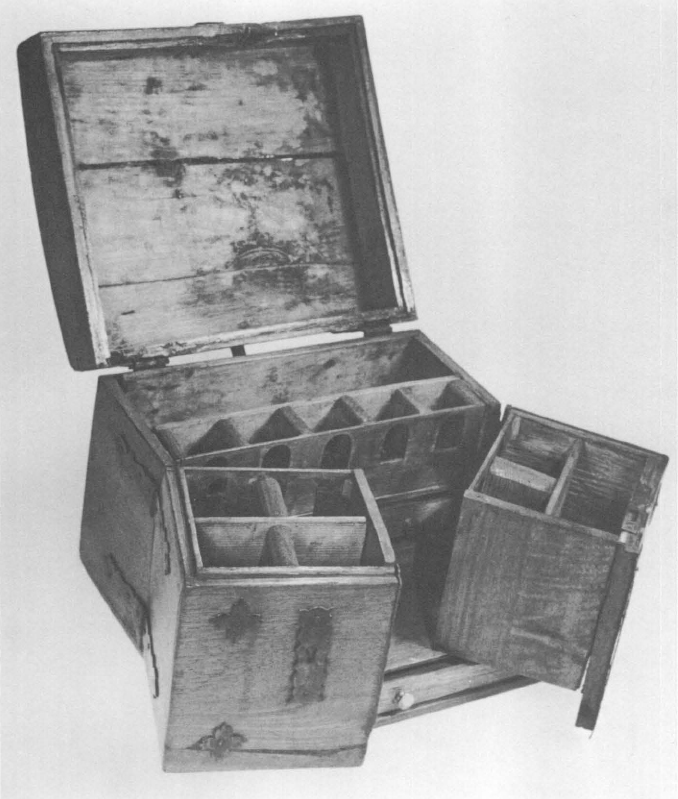
77. Drug chest, seventeenth century, probably from continental Europe but used in colonial America. Courtesy David Gunner.
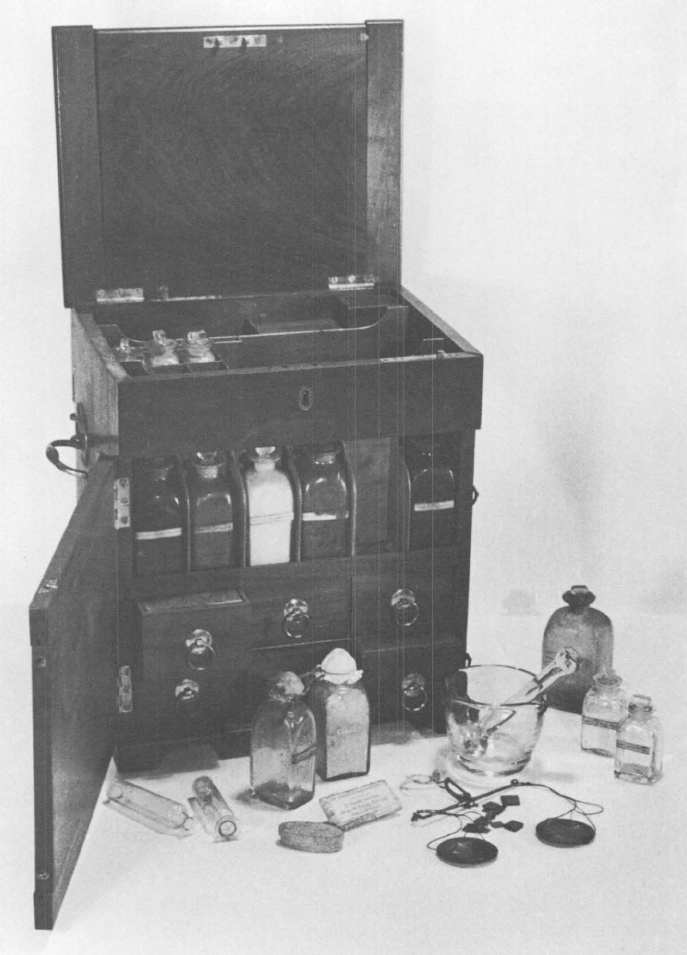
78. Home medicine chest, manufactured by W. Crawley, London, about 1790. See accompanying text for details of the chest’s contents. Photograph by David Gunner. Courtesy Boston Medical Library.
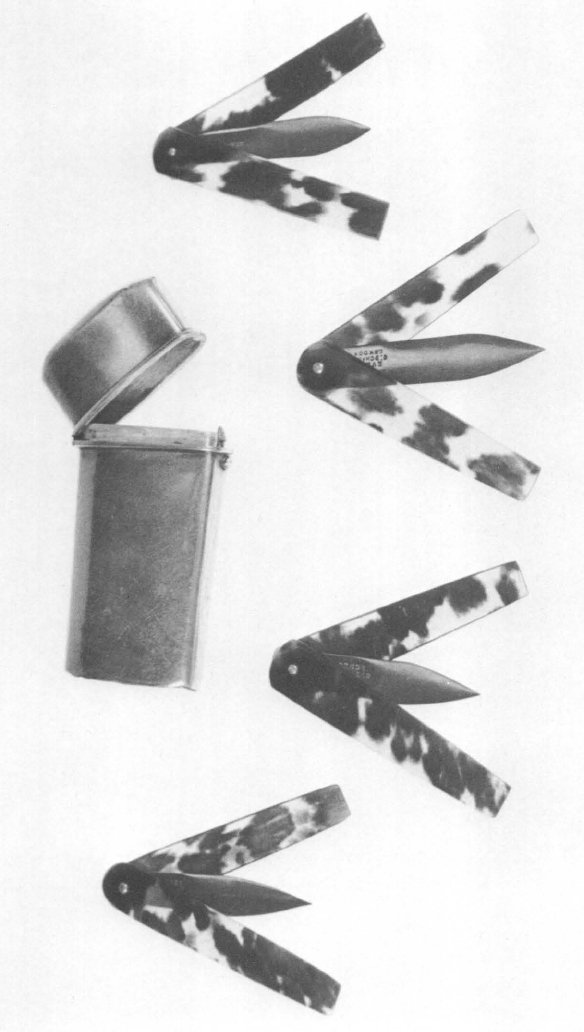
79. Lancets and lancet case. The lancets, of slightly different shapes and lengths, are steel, with tortoise-shell protectors, and fit in the silver case. The lancets, and probably the case, were made in England during the reign of George III. Photograph by David Gunner. Courtesy J. Worth Estes.
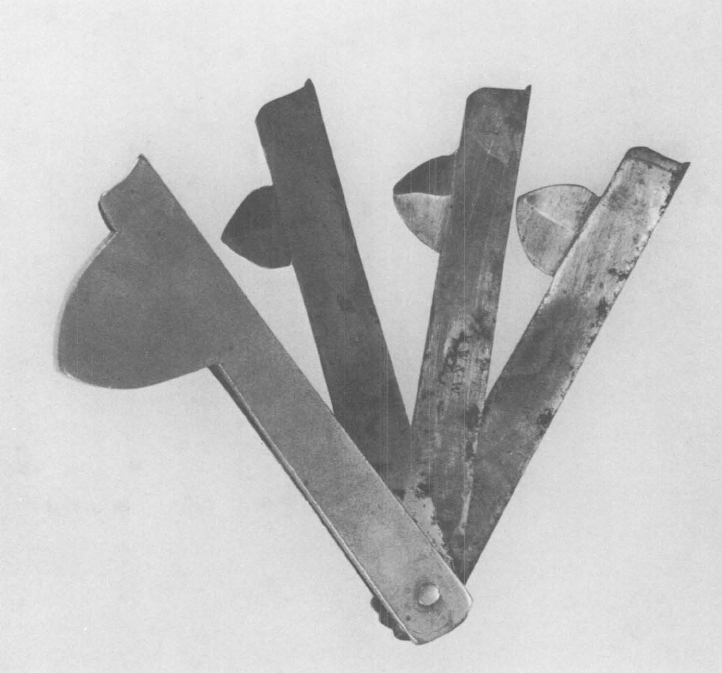
80. Fleam (sometimes spelled “phleam”). Three steel blades hinged to a brass case. Probably made in New England, 1750–1820. Photograph by David Gunner. Courtesy Boston Medical Library.
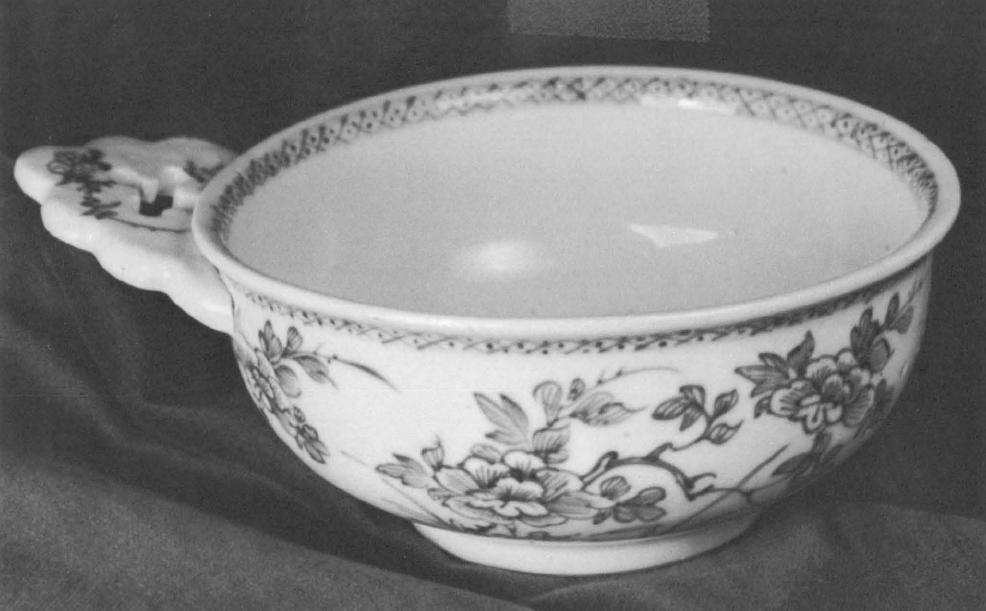
81. Porcelain bleeding bowl. Made in China for export to the West, in the shape of an ordinary household porringer. Photograph by David Gunner. Courtesy Lloyd E. Hawes.
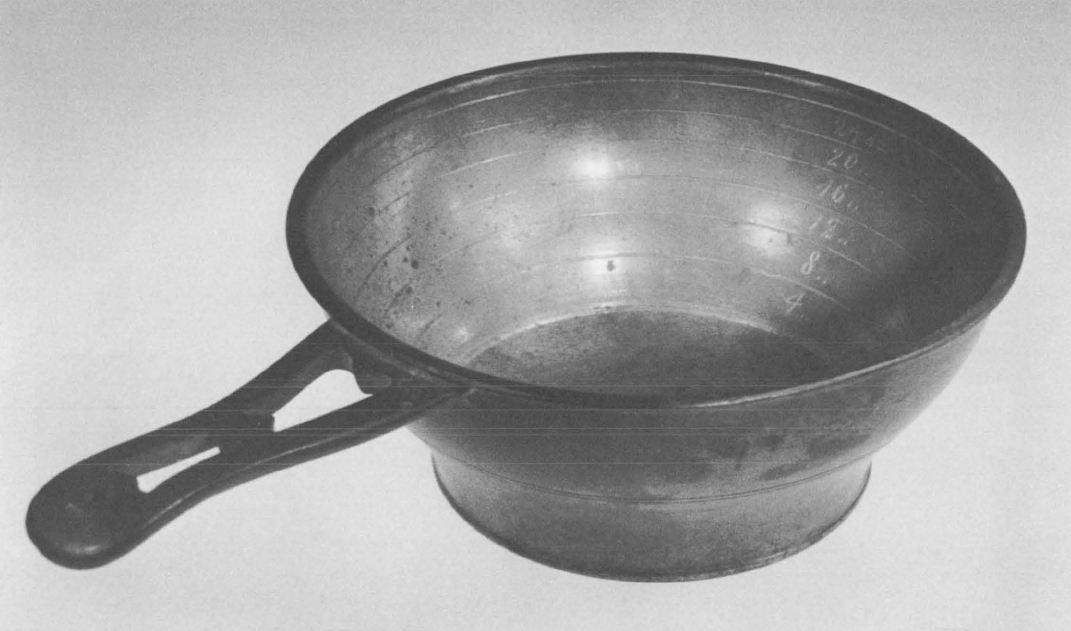
82. Pewter bleeding bowl. Made by John Ferris & Company, Exeter, England, 1780–1795. Graduations, to facilitate removal of specific amounts of blood in multiples of four ounces up to twenty-four ounces, are incised inside the bowl opposite the handle. Photograph by David Gunner. Courtesy J. Worth Estes.
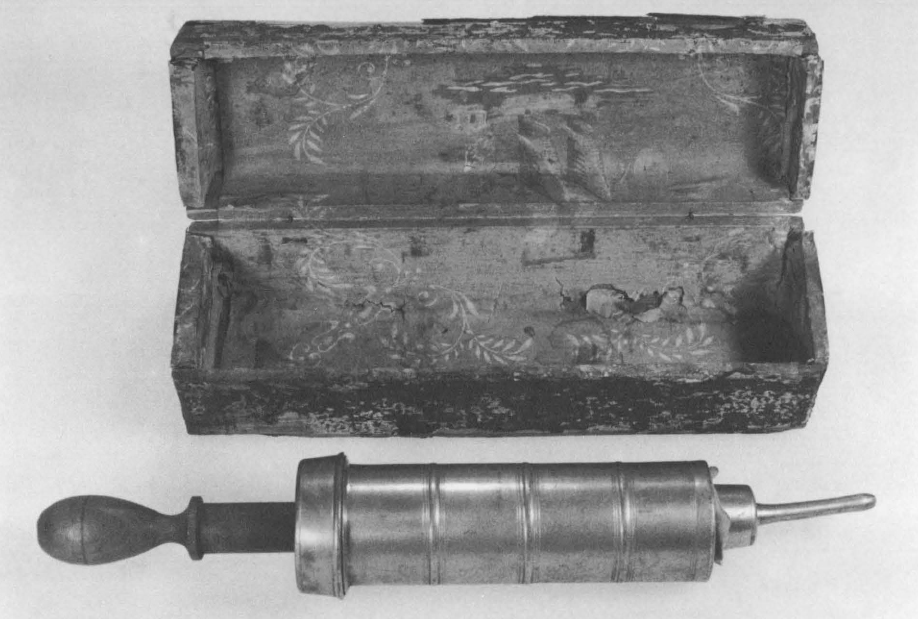
83. Pewter glyster (sometimes spelled “clyster”), a syringe for administering drugs as enemas, in a decorated wooden box. Late eighteenth century. Photograph by David Gunner. Courtesy Boston Medical Library.
Made for home use, Crawley’s medicine chest is typical of the most elaborate such outfits which found their way to colonial America, where they were used by physicians as well as their patients. In addition to tools such as scales, weights, and mortar and pestle, the chest contained forty-one drugs, probably intended to provide first-aid, or temporizing relief. The specific uses of each drug as recommended by the manufacturer differ slightly from those specified by James Thacher in New England, but the same overall general pattern of drug uses and indications emerges from both kinds of data.
In the list below, abstracted from the booklet of directions included in the chest, each drug’s indications and the doses recommended for adult patients are given, followed by, in parentheses, the frequency with which it occurs in the combined practices of Drs. Bartlett, Rowe, Aspinwall, and Townsend (as calculated from the data in Tables XI and XII). See Appendix I for terms not defined in the list. That the drugs in this chest made up just over 38% of all those used in the four New England practices suggests that it, and others like it, were designed to be of service in the most commonly encountered disorders.
acid elixir: Strengthener, stomachic; for loss of appetite and for debility; five to fifteen drops twice daily. (0.78%)
antimonial drops: As diaphoretic, ten to forty drops; as emetic, one to two ounces. (0.08%)
antimonial emetic powder: As emetic and febrifuge; one grain in one gill of water, given as one tablespoon an hour, less frequently as febrifuge. (0.57%)
aperient electuary: Cathartic. (0%)
bark: For fevers, especially intermitting fevers, and as a tonic; three drains to one ounce (16 drams) in port wine every hour. (7.54%)
blistering plaister: For most fevers, coughs, asthmas, pleurisies; spread on breast, between shoulders, or on rear of neck, for twelve to twenty-four hours, and follow with fresh lard. (0.05%)
calomel: As an “alterative” (any medicine that restores health to normal), for venereal disease, and as an anthelminthic; one, two, or three grains, (1.03 %)
camphor: For inflammatory and putrid fevers, occasionally for fluxes, and for strangury and chilblains; two drams to one ounce (16 drams). (9.33%)
cordial confection: To increase the pulse when low, as occurs in some fevers; one scruple (20 grains) to one ounce (438 grains). (0.17%)
cream of tartar: A gentle aperient, three drams to one-half ounce (8 drams); as a refrigerant, give one scruple (20 grains) with one scruple of Nitre (q.v.). (0.73%).
daffy’s elixir: A stomachic purgative for weak stomachs and bowels; two to three tablespoons. (0%)
diachylon plaster: For small cuts and excoriations; for external application. (0.26%)
essence of peppermint: A carminative, for stomach complaints; ten to fifteen drops on a piece of sugar, dissolve in water. (0.05 %)
febrifuge drops: For lesser fevers of children, ten to twenty drops every four hours in sagoe tea; for strangury in adults, forty to sixty drops every four hours. (1.21%)
fit drops: For women with hysterical complaints, and children with worms; sixty to one hundred drops every four hours (?0%)
gascoigne’s powders: An antidiarrheal for children with “disordered bowels”; five grains to one ounce (438 grains) (?0%)
goulard’s extract: A cooling wash for severe injuries, of lead salts. (Similar preparations comprise 1.69% of the four New England practices.)
gum plaister: A bile stimulant for children. (0.06%)
hartshorn drops: For rousing the spirits; twenty to sixty drops. (0.07%)
hoffman’s drops: For nervous disorders, especially low fever, and stomach complaints associated with hysterical disorders; twenty to sixty drops. (?0%)
huxham’s tincture: Cordial restorative, to be given after a fever, and to stimulate the appetite; one tablespoon three times daily. (See bark above)
ipecacuanha: A safe vomit for fluxes; two to ten grains for children, ten to twenty grains for adults. (0.16%)
jallap: A powerful purge, for dropsy and colds; twelve grains to one dram (27 grains). (0.16%)
james’s powder: For curing fevers; three to ten or more grains, as necessary. (Contains antimony; see antimonials above)
laudanum: “Is principally given to procure rest and relieve pain”; twenty-five to thirty drops, less for children. (All opiates comprised 3.31% of the four New England practices.)
magnesia: A mild laxative for stomach acidity and heartburn; one to four teaspoons, depending on age and condition. (0.33%)
milk of sulphur: For piles and itch; one dram to one-half ounce (420 drams) twice daily. (Flowers of Sulfur, 0.92%)
musk: A cordial for all nervine diseases such as low nervous fever (debility), all convulsions and fits, and mad dog bites; one dram to one ounce (16 drams). (0.02%)
nitre: A cooling febrifuge; five to twenty grains. (2.53%)
palsy drops: A cordial, carminative, for sluggish disorders of the brain, as a stimulant; also for stomach complaints and hysterical disorders; contraindicated for inflammatory constitutions; twenty to sixty drops. (?0%)
pectoral drops: A mild anodyne, and for tickling coughs; twenty to sixty drops at bedtime. (0.49%)
pile ointment: No specific directions given. (0%)
rhubarb: Purge; or, when toasted, an astringent; one-half to one ounce. (2.57%)
rochelle salts: Purge and refrigerant; one-half to two drams in divided doses until desired effect is obtained. (Note: This is same as cream of tartar, which see above.)
salt of wormwood: For fever, especially bilious fever, and vomiting; one ounce in divided doses. (0.01%)
traumatic balsam: For inward wounds, bruises, or coughs; ten to thirty drops in any tea; to lessen bleeding from a wound, apply externally. (0.06%)
turner’s cerate: For red and healthy ulcers; apply externally. (0.13%)
venice treacle: Warm anodyne and diaphoretic. (Note: This is a mild opiate; see laudanum above.)
volatile drops: A powerful cordial for low spirits and fainting; twenty to sixty drops. (2.15%)
worm powder: One dram to one ounce (16 drams). (0.76%)
yellow basilicon: A digestive for foul ulcers. (0.99%)
